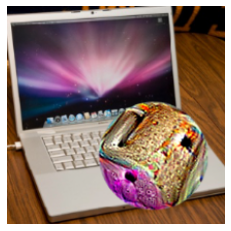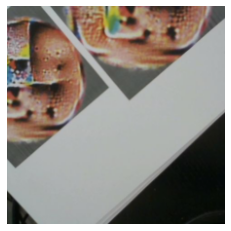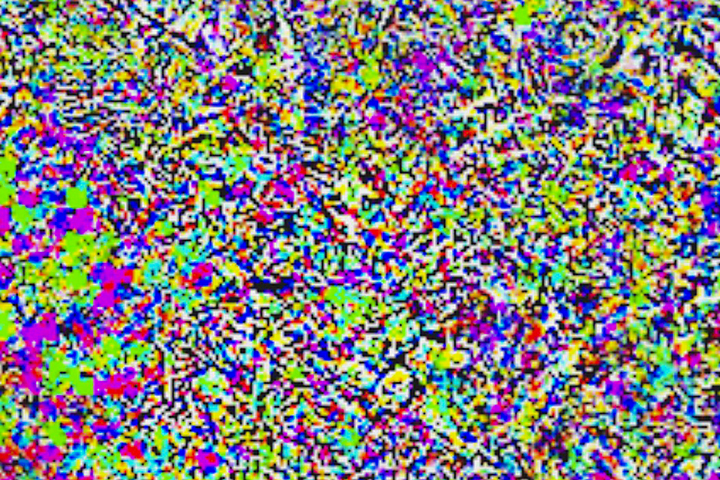Adversarial Patch Detection¶
In this notebook we will be using the attack Adversarial Patch introduced in [BMR+18].
As in FGSM and BIM and One Pixel Attack we will use PyTorch.
import os
import glob
from typing import List, Tuple
import numpy as np
import matplotlib.pyplot as plt
import torch
import torch.nn as nn
import torch.nn.functional as F
import torchvision
from torchvision.transforms import *
from PIL import Image
import matplotlib.pyplot as plt
data_folder = os.path.join('data/')
# setting a random seed makes the random number generator deterministic and reproducible
np.random.seed(42)
torch.backends.cudnn.deterministic = True
torch.manual_seed(1)
torch.cuda.manual_seed(1)
# use compatible NVidia GPU if available
if torch.cuda.is_available():
device = torch.device('cuda')
print('cuda found!')
else:
device = torch.device('cpu')
print('no cuda found')
no cuda found
Loading the model¶
To be able to use this attack, first we need to select the machine learning model that we will use as an image classifier. For that purpose, we we will use the models available in the library torchvision, that is part of pytorch
These models have been pre-trained in 1000 categories from the image dataset ImageNet.
We can find the models available in torchvision in the torchvision website.
# we set the parameters pretrained and progress to True, to download the pretrained model with a progress bar
net = torchvision.models.resnext50_32x4d(pretrained=True, progress=True)
# when we load a model with pytorch, by default it is in train mode
# as we are going to use the model to make predictions we set it with evaluation mode
# with the ; we hide the output that was going to be printed out
net.eval();
# we pass the model to the device just with this one line of code
net.to(device);
We also need to load the labels associated to the categories used to train the model. In this case the categories are the 1000 used in the competition ImageNet Large Scale Visual Recognition Challenge.
In the text file synset_words.txt you can see all the categories of images that the mode has been trained on. These categories, also known as synsets, were inheret from project WordNet
They use several keywords to describe each category. In the file synset_words.txt, I abbreviated these keywords. You can find the original list in this link: https://gist.github.com/fnielsen/4a5c94eaa6dcdf29b7a62d886f540372
with open(os.path.join(data_folder, 'synset_words.txt'), 'r') as f:
synset_words = [' '.join(s.replace('\n', '').split(' ')[1:]) for s in f.readlines()]
np.random.choice(synset_words, 5)
array(['echidna, spiny anteater, anteater',
'bathtub, bathing tub, bath, tub',
'tobacco shop, tobacconist shop, tobacconist',
'white wolf, Arctic wolf, Canis lupus tundrarum', 'wombat'],
dtype='<U121')
Loading and visualizing images¶
As previously, we need some pre-processing on our images before we can use them in the neural net.
But first, lets load a manipulated image.
images = {}
for file_name in glob.glob(os.path.join(data_folder, 'images', 'toaster-*.jpg')):
# remove file extension and path
short_file_name = os.path.splitext(os.path.split(file_name)[-1])[0]
images[os.path.splitext(short_file_name)[0]] = {
# Image is from PIL library
'image': Image.open(file_name)
}
print(f"loaded {file_name}")
loaded data/images/toaster-resnet-1.jpg
IMAGENET_MEAN = np.array([0.485, 0.456, 0.406])
IMAGENET_STD = np.array([0.229, 0.224, 0.225])
preprocess_alexnet = Compose([
Resize(224),
CenterCrop(224),
ToTensor(),
Normalize(IMAGENET_MEAN, IMAGENET_STD)
])
def plot_image(img_tensor: torch.tensor, dataset_mean: np.array = IMAGENET_MEAN, dataset_std: np.array = IMAGENET_STD) -> None:
img_tensor = img_tensor.permute(1, 2, 0)
img_np = img_tensor.detach().cpu().numpy()
# _STD[None, None] adds 2 dimensions so we are multiplying the color dimension of the picture
img_np = (img_np * dataset_std[None,None]) + dataset_mean[None,None]
img_np = np.clip(img_np, a_min=0.0, a_max=1.0)
# we plot the image
plt.figure()
plt.axis('off')
plt.imshow(img_np)
Once we load the image, we are going to conduct a pre-processing step.
original_img_tensor = preprocess_alexnet(images['toaster-resnet-1']['image'])
plot_image(original_img_tensor)

Using the model to predict the content of the image¶
Then with the function predict_image_top_categories() we use the model to predict the content in the image. This function returns the number of categories, defined by the parameter num_top_cat, with a higher probability predicted by the model.
def predict_image_top_categories(
img_tensor: torch.tensor,
model: torchvision.models,
labels: List[str],
device: torch.device,
num_top_cat: int = 5
) -> List[List[str]]:
# create a mini-batch as expected by the model
# add an extra batch dimension since pytorch treats all images as batches
input_batch = img_tensor.unsqueeze(0)
# we send it to the device
input_batch = input_batch.to(device)
# forward pass, it returns unnormalized scores
output = model(input_batch)
# we use the Softmax function to get the probability distribution over categories
probabilities = torch.nn.functional.softmax(output[0], dim=0).cpu()
# show top categories per image
top_prob, top_catid = torch.topk(probabilities, num_top_cat)
return top_prob, top_catid
print('Prediction Original image:')
top_pred_conf, top_pred_idx = predict_image_top_categories(original_img_tensor, net, synset_words, device, num_top_cat=5)
for conf, cat_id in zip(top_pred_conf, top_pred_idx):
print(f'Confidence {conf:.2%}\t{cat_id}\t{synset_words[cat_id]}')
pred_conf = top_pred_conf[0]
pred_idx = top_pred_idx[0]
pred_label = synset_words[top_pred_idx[0]]
Prediction Original image:
Confidence 98.35% 859 toaster
Confidence 1.43% 626 lighter, light, igniter, ignitor
Confidence 0.10% 710 pencil sharpener
Confidence 0.03% 742 printer
Confidence 0.02% 673 mouse, computer mouse
We see that by placing a specific digital patch on the image we can trick the net to predict wrong.
The code to generate this patch can be seen here. The code needs some mantaining as it relies on old versions of dependencies.
Patches in real life¶
The nice thing about these badges is that those patches do not only work on manipulated digital images but also as real life. For this we want to take a look at it by placing those batches in the real world and taking a photo of it.
The interactive version relies on Google Colab - therefore the interactive part is omitted here and instead we will rely on a static image. Feel free to replace this image with your own.
webcam_image_path = os.path.join(data_folder, 'images', 'webcam.jpg')
webcam_image = Image.open(webcam_image_path).convert('RGB')
img_tensor = preprocess_alexnet(webcam_image)
plot_image(img_tensor)

num_top_cat = 5
top_pred_conf, top_pred_idx = predict_image_top_categories(
img_tensor,
net,
synset_words,
device,
num_top_cat
)
for conf, cat_id in zip(top_pred_conf, top_pred_idx):
print(f'Confidence {conf:.2%}\t{cat_id}\t{synset_words[cat_id]}')
Confidence 48.16% 61 boa constrictor, Constrictor constrictor
Confidence 31.14% 62 rock python, rock snake, Python sebae
Confidence 11.91% 60 night snake, Hypsiglena torquata
Confidence 1.66% 66 horned viper, cerastes, sand viper, horned asp, Cerastes cornutus
Confidence 1.08% 32 tailed frog, bell toad, ribbed toad, tailed toad, Ascaphus trui
References¶
For more applications in real life check out [WLDG20], [XZL+20] and [SBBR16].
Bibliography¶
- BMR+18
Tom B. Brown, Dandelion Mané, Aurko Roy, Martín Abadi, and Justin Gilmer. Adversarial patch. 2018. arXiv:1712.09665.
- SBBR16
Mahmood Sharif, Sruti Bhagavatula, Lujo Bauer, and Michael K. Reiter. Accessorize to a crime: real and stealthy attacks on state-of-the-art face recognition. In Proceedings of the 2016 ACM SIGSAC Conference on Computer and Communications Security, CCS '16, 1528–1540. New York, NY, USA, 2016. Association for Computing Machinery. URL: https://doi.org/10.1145/2976749.2978392, doi:10.1145/2976749.2978392.
- WLDG20
Zuxuan Wu, Ser-Nam Lim, Larry Davis, and Tom Goldstein. Making an invisibility cloak: real world adversarial attacks on object detectors. 2020. arXiv:1910.14667.
- XZL+20
Kaidi Xu, Gaoyuan Zhang, Sijia Liu, Quanfu Fan, Mengshu Sun, Hongge Chen, Pin-Yu Chen, Yanzhi Wang, and Xue Lin. Adversarial t-shirt! evading person detectors in a physical world. 2020. arXiv:1910.11099.
